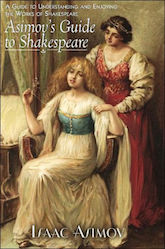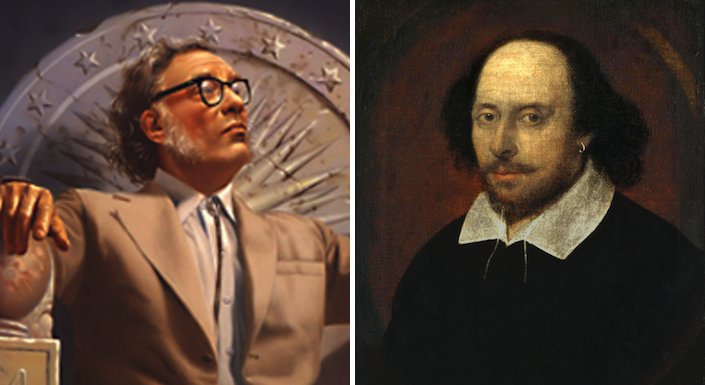“So, she pulls out this book…” The way my friend turns on his barstool and smiles tells me this is going to be something good.
We’re sitting at a quiet bar, chatting about his latest acting gig—Much Ado About Nothing. The ‘she’ in question is the director, and the book is Asimov’s Guide to Shakespeare. Being well aware of my proclivities, he assumed I would want to know that Isaac Asimov once wrote a two-volume handbook to understanding each and every single one of the Bard’s plays (plus two of his poems), including plot summaries, fact-checks against historical events, definitions of outdated terms, and explanations of the jokes that don’t make as much sense after four centuries; in short, everything an obsessive word nerd could want as a companion to Shakespeare. I bought a copy online immediately and then ordered another beer.
While I had heard nothing about this book, the connection immediately seemed obvious. Of course the voracious Asimov decided one day that he wanted to get every reference in all of Shakespeare’s works, and of course he wrote his findings into a book so others could share his excitement.
When a writer writes about another writer, the reader can’t help but learn something about them both. As soon as I got my hands on the thing (both hands; it’s 800 pages) and cracked it open, the wry tone, the relatable language, the ridiculously broad and deep knowledge, the sheer Asimovness of the book was evident. So how does this master of sci-fi approach Shakespeare? From his introduction:
This is not to say that one cannot enjoy Shakespeare without knowing the historical, legendary, or mythological background to the events in his plays. There is still the great poetry and the deathless swing of his writing. —And yet, if we did know a little more of what that writing was about, would not the plays take on new dimension and lend us still greater enjoyment?
This is what it is in my mind to do in this book.
(Note to self: use the phrase ‘deathless swing’ as often as is viable.)
Buy the Book


Asimov’s Guide to Shakespeare: A Guide to Understanding and Enjoying the Works of Shakespeare
As a person—like so many others—who digs SFF literature and Will’s plays, I’ve always leaned toward the magic stuff. I want fairy royalty. I want wizards on desert isles. And while Troilus and Cressida doesn’t actually include any of the Greek pantheon, it does have Odysseus. I hadn’t ever read it, so now armed with Asimov’s annotations, I gave it a shot.
His introductory summary of The Iliad floors me: “The episode… deals with a quarrel between two of the Greek leaders, with the near disaster that befalls the Greek cause as a result, and with the dramatic reconciliation that follows after all the participants have suffered tragic losses.” It’s as relatable as a Netflix blurb. Forget blurry-eyed reverence; nowhere is the god-like Homer sitting down to create a mighty epic, blind eyes staring to the Muse for guidance.
As he proceeds, Asimov lays out the history. Histories, I should say. The actual history of Troy as we understand it. The history of Homer himself. The history of different treatments and versions of the Trojan War, right up until recent times. After telling us that the first translation of Homer into English hadn’t been finished yet when Shakespeare wrote the play, he takes a canon-obsessed nerd’s joy in pointing out where the Bard gets it wrong. Mental images of red pen marks and tutting smiles abound.
If the ridiculously informative annotations on all of these aspects aren’t enough for you, how about Asimov’s theories that Shakespeare was referring to contemporary events? That a scandal about his patron’s faction in court crept into the depiction of Cressida? Asimov’s knowledge is recursive—the harder you look, the more detail you find.
We also see Asimov trying to get inside Shakespeare’s head, not from the standpoint of poetry, but of craft. At the end of the fourth act he maps out Shakespeare’s options for killing Troilus or not like an equation: “He must die. Troilus dies, in the Greek legends that deal with him, and of what dramatic value is it to survive under the conditions of the tragedy as outlined in this play?”
Conditions. Value. These are math terms. Problem-solving terms. Asimov is envisioning Shakespeare trying to work through the kind of problem any writer deals with: Do I kill him or not? What evokes the strongest feelings without being heavy-handed or trite? Just what the heck am I building toward here?
And that is part of the beauty of this book. It is not simply a delicious pre-hypertext nerd-fest. It’s about how to write.
Having sated my writer side with this reading, I asked the director, Buffalo theatre luminary Kyle LoConti, about how she has used the book in production. What does the book offer people actually staging the plays?
This was always my favorite source for ‘fun facts,’ maps, family trees and so on. While most of the information isn’t ‘actable,’ it does deepen the actors’ (and director’s and designers’) understanding of the universe of the play—as it would have been understood in Elizabethan England by Shakespeare and his audience.
Now that I am directing Shakespeare, I love learning all of this information to help place me in the universe of the play. Most resources give plot summaries, character breakdowns, thematic treatises and such. Asimov’s attack on understanding the canon is so refreshingly unique and so much fun for Bard-wonks like me.
(Note to self: use the term ‘Bard-wonk’ as often as is viable.)
I went to see the performance of Much Ado a week later, and of course prepped myself with old Isaac’s essay. It contains my favorite of his notes so far: when mopey Don John is described as being born under Saturn, Asimov provides the astrological context. “Saturn…is the slowest moving of the planets and is named for a particularly ancient god. Those born under his influence are therefore ‘saturnine,’ that is, grave, gloomy, and slow”.
Etymology, astronomy, astrology, and the history of mythology all in one sentence, without a whit of pedantry. Is there anything more Asimovian than that?
Top Image: Portrait of Isaac Asimov by Rowena Morrill; the Chandos Portrait of William Shakespeare.
 Alex Livingston lives in an old house with his brilliant wife and a pile of aged video game systems. He writes speculative and interactive fiction, most recently the cyberpunk novella Glitch Rain. He’s on Twitter as @galaxyalex.
Alex Livingston lives in an old house with his brilliant wife and a pile of aged video game systems. He writes speculative and interactive fiction, most recently the cyberpunk novella Glitch Rain. He’s on Twitter as @galaxyalex.










